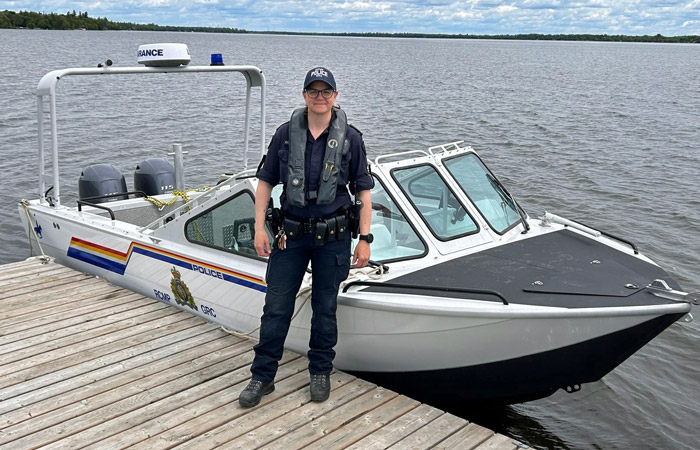The RCMP Underwater Recovery Team (URT) was in Lac du Bonnet on June 27, 2024, to bring awareness to some of the causes of drownings. URT has been called out to four drownings already in 2024, and if previous years tell us anything it is that they can expect to be called out to more.
“When my team arrives on scene, it is not typically in a rescue capacity,” said Corporal Kathryn Ternier, Head of the RCMP URT. “We are coming to recover someone from the water. I am asking you, the public, to put me out of a job recovering drowning victims.”
While URT also dives to assist other RCMP units in locating items underwater that are related to an investigation, it is the grim task of recovering drowning victims that keeps URT busy.
“We talk a lot about life jackets and personal floatation devices,” said Corporal Ternier, “and they are so crucial to water safety. However, we also need to be talking about what happens that lands people in the water or makes them unable to survive in the water once they are in there.”
Regardless of how strong a swimmer one feels they are, there are obstacles in the water that can affect anybody’s ability to stay afloat. Dams can be very dangerous. They create powerful currents and turbulence that can pull swimmers underwater or into the dam. Even de-commissioned dams or bridge structures can be dangerous due to hazards that accumulate underwater by these structures that can entangle a swimmer.
Fast-moving water is another concern. Many people like to hike by rapids or camp close to fast-moving water, but this is not always a good idea when children are involved.
“We have seen family hikes turn deadly because they decided to hike near swift-moving water and a child slipped and went in the water,” said Corporal Ternier. “Always keep a safe distance from the water if you are not wearing a lifejacket or PFD. Three metres to 10 feet is a good rule,” she added.
The beach is another place things can go wrong quickly. “We have seen instances where parents look away from their child for an instant at the beach, as short a time as putting the camera down, and tragedy has struck,” said Corporal Ternier.
“One of the keys to being safe in, on or around the water is being prepared. That means knowing what the weather will be like, having the right equipment such as a lifejacket, and being ready to enter the water even if you have no plans on going into the water,” said Stacey Grocholski, Executive Director of Lifesaving Society Manitoba. “It is also imperative that children are always supervised. Manitoba is among the provinces with the highest number of drowning deaths per capita of children five years of age and under.”
Corporal Ternier emphasizes that she does not want people to be fearful of the water, but to respect it. Practice vigilance – know the body of water you are swimming in, and if you are unfamiliar, ensure you are wearing a lifejacket or PFD as appropriate. Avoid obstacles. Don’t swim alone. Stay away from fast-moving water. Always swim sober.
“Water is very unforgiving,” Corporal Ternier said. “One slip of your foot and you could be fighting for your life.”





